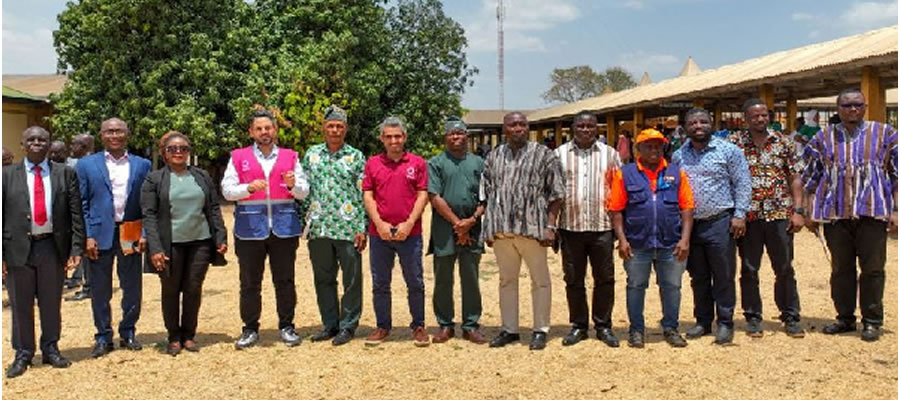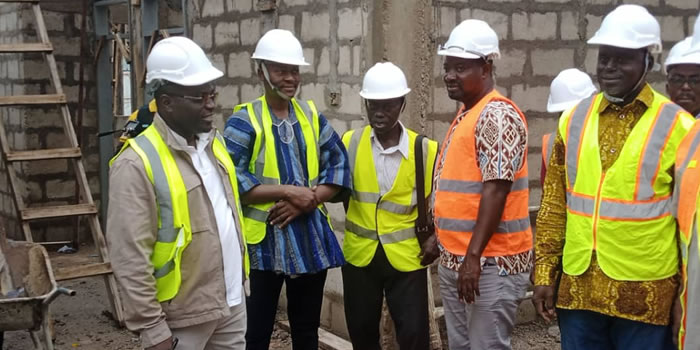

Bathing and Toilet facilities
Toilet facilities
Table 8.11 shows the type of toilet facility and bathing facility used by households by type of locality. The table shows that 10.5 percent of households in the district use public toilet (WC/KVIP/Pit/Pan). Significant proportion of households used public toilets (KVIP) (5.7%) and Pit latrine (5.6%). A very small proportion of households use water closet (0.2%). Negligible proportions of households also use the bucket/pan (0.1%) which has been banned in some districts. 77.6 percent of household in the district have no toilet facilities.
However, the proportion of households who do not have no toilet facilities is higher in rural localities (83.8%) than for those in urban localities (54.1%). The use of public toilet (WC/KVIP/Pit/Pan) is more common in urban (40.7%) than rural areas (2.6%). There is, however, little variation between urban localities (4.1%) and rural (6.2%) localities with regard to the use of KVIP in the district. The proportion of households who use water closet is higher in urban localities (0.4%) than the same proportion for rural localities.
Bathing facilities
Table 8.11 shows that there are four main types of bathing facilities in the district. They include shared separate bathroom in the same house (39.8%), which is the most bathing facility in the district. Other bathing facilities include own bathroom for exclusive use of household (27.8%), shared opened cubicle (13.6%) and open space around house (7.6%). About eight percent of households use public bath houses and one percent of households use river/ponds/lake/dam.
Higher proportions of rural households (43.1%) than urban households (13.9%) use shared separate bathroom in the same house and shared open cubicle separate bathroom respectively. Table 8.1 also reveals that the use of own bathrooms (exclusive use) and use of open space around the house for bathing is more prevalent in the urban than in the rural areas. There was little variation between urban (0.0%)) and rural localities (0.3%) with regard to households that use bathrooms in another house.
Method of Waste Disposal
Methods of solid waste disposal
The methods of solid and liquid waste disposal by locality are presented in Table 8.12.Generally the main method of rubbish disposal in the country is through public dumping (open space) and through dumping indiscriminately. This pattern which is observed at the national level is also observed at the regional and district levels.
The common methods of solid waste disposal in the District is by public dump (58.2%), followed by dumping indiscriminately (23.5%). Public dump (container) was practiced by as high as eight percent of households in the district. Burning as a way of waste disposal by households is not common in the district, only about 10 percent of the households in the district use this method. Three percent of households depend on companies to collect their household waste while less than one percent households bury their refuse.
The proportion of households who use public dump method of solid waste disposal is high in both rural households (62.9%) and urban households (40.2%) in the district. However, high a percentage of households in urban localities (34.7%) also dispose of waste by public dump (container). On the other hand disposal of waste by means of burying was not very popular in the rural localities (0.8%). There is little variation in the proportion of households in both the urban (6.1%) and rural (5.9%) localities whose solid waste is buried. More urban households (4.4%) as compared to rural households (2.7%) use the services of rubbish collecting companies. This is possibly due to the availability of collecting companies in urban areas.
Liquid waste disposal
Table 8.12 shows that about 57 percent of the total households in the district throw their liquid waste onto the street/outside of their houses. One out of every three households, (29.3%), threw their liquid wastes onto the compound of their homes and about six percent threw their liquid waste through drainage into a pit. Less than two percent of households dispose of liquid waste through drainage into a gutter. Disposal of liquid through the sewerage system is also used by a small proportion of households (1.3%).
The disposal of liquid waste by throwing onto the street/outside is the main method use by households in both urban (41.7%) and rural (60.4%) localities. Higher percentage of rural households (30.0%) compared to urban households (26.4%) poured liquid waste onto their compound. There is a wide variation between urban (16.5%) and rural (1.7%) households who throw their liquid waste into gutters. However, there is no variation between the two localities with regard to disposal through drainage into a pit (soak away) and other disposal methods which registered (6.4% and 0.2%) in the urban areas and (6.4% and 0.3%) in the rural areas.
Date Created : 12/20/2017 6:06:59 AM











 facebook
facebook
 twitter
twitter
 Youtube
Youtube
 +233 593 831 280
+233 593 831 280 0800 430 430
0800 430 430 GPS: GE-231-4383
GPS: GE-231-4383 info@ghanadistricts.com
info@ghanadistricts.com Box GP1044, Accra, Ghana
Box GP1044, Accra, Ghana